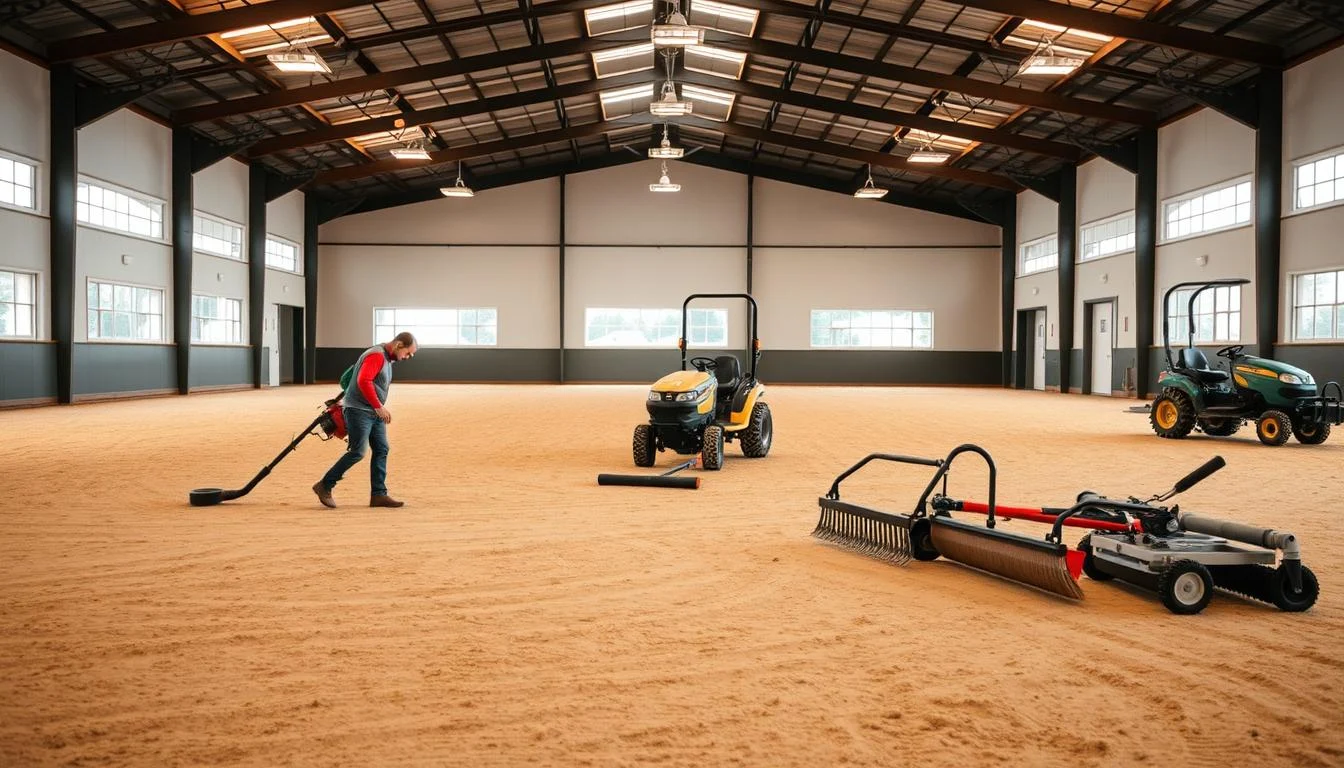Did you know over 80% of equestrian facilities in Canada now include a covered training space? These structures aren’t just luxury additions—they’re game-changers for riders facing unpredictable weather. A well-designed space for horse activities ensures year-round training, protects animals from extreme temperatures, and even boosts performance through specialized footing.
Modern riding halls go beyond basic shelters. Their layouts often include adjustable lighting, advanced ventilation systems, and shock-absorbent surfaces. These elements work together to create ideal conditions for both casual riding and competitive preparation.
Choices in building materials—like durable steel frames or eco-friendly timber—directly impact longevity and maintenance costs. Some Canadian facilities even use tensioned fabric roofs to balance natural light with insulation during harsh winters.
Key Takeaways
- Year-round usability transforms training consistency
- Specialized flooring reduces injury risks
- Climate control systems protect horse health
- Material choices affect long-term costs
- Proper design enhances rider safety
Understanding Indoor Riding Arenas
Different terms like “riding hall” and “indoor ring” refer to structures designed for all-weather equestrian activities. While Canadians often use “indoor arena,” Europeans might say “manège” for the same concept. Clear terminology helps riders compare options when planning their spaces.
Definition and Common Terminology
An indoor riding arena is a fully enclosed structure with surfaces tailored for equine movement. These spaces differ from outdoor riding arenas through their climate control and consistent footing. Terms like “covered ring” (common in the US) emphasize protection from rain or snow, while “training hall” suggests competitive-grade facilities.
Benefits of Training in a Controlled Environment
Stable temperatures prevent horses from overheating in summer or stiffening in winter. Riders gain predictable conditions for practicing jumps or dressage patterns without wind interference. One Ontario trainer notes: “Our covered space cut cancellations by 60% last year – it’s transformed how we prepare for shows.”
Quality footing materials reduce slips, addressing key safety concerns. Properly designed walls and entryways also minimize spooking risks from sudden noises. These factors combine to create an environment where both beginners and pros can focus on technique rather than weather battles.
Designing Your Ideal Indoor Riding Arena
Building a space for equestrian training requires balancing practicality with smart design. The right layout and materials determine how well your facility supports daily workouts and long-term goals. Let’s explore how to create a space that works for both casual riders and competitive athletes.
Space Planning for Maximum Efficiency
A 60’ x 120’ footprint suits most training needs, but competitive setups often stretch to 200’ lengths. Clear-span structures – those without interior columns – prevent obstacles during jumps or dressage drills. This open concept also simplifies future layout changes.
Comparing Building Methods
Three main construction types dominate Canadian projects. Each offers unique advantages:
| Type | Pros | Cons |
|---|---|---|
| Post-Frame | Affordable, fast build | Limited snow load capacity |
| Steel | Durable, handles heavy snow | Higher upfront cost |
| Fabric | Natural light, modular | Shorter lifespan |
Steel buildings excel in regions with harsh winters, like Alberta or Quebec. Their rigid frames support thicker insulation layers. Fabric options work well for seasonal use but may need replacements every 10-15 years.
When choosing materials, consider maintenance needs. Pressure-treated timber requires regular sealing, while galvanized steel resists rust. One Ontario barn owner shares: “We prioritized durability – our steel frame has outlasted two neighboring wooden arenas.”
Features of Indoor Riding Arenas
Modern training structures prioritize three pillars: air quality, visibility, and accident prevention. Smart choices in layout and materials turn basic shelters into high-performance spaces where both horses and riders thrive.
Fresh Air Flow and Visibility Solutions
Proper ventilation prevents dust buildup – a major respiratory risk. Cupolas and sliding doors create natural airflow patterns. One Alberta trainer notes: “Our new ridge vents cut hay particle concentration by 40% within weeks.”
Side-mounted lighting reduces glare compared to overhead fixtures. LED strips along walls provide shadow-free illumination for evening sessions. Skylights work well in southern regions but may cause ice buildup in Canadian winters.
Durable Materials and Accident Prevention
New composite wall panels combine insulation with scratch-resistant surfaces. These interior finishes withstand kicks while maintaining bright, welcoming spaces.
Clear span designs eliminate support beams that could cause collisions. Safety buffers (8-10ft minimum) around perimeters give spooked horses room to settle. Rider guards on gates prevent loose animals from bolting.
| Element | Function | Canadian Adaptation |
|---|---|---|
| Insulated Roof | Retains heat | 6” thickness recommended |
| Sliding Doors | Controlled airflow | Double-track for snow clearance |
| Non-Slip Edging | Footing stability | Heated thresholds in Quebec |
Selecting the Right Footing and Surface
The foundation of any great training space lies beneath your boots – and your horse’s hooves. A well-engineered base prevents slips, cushions joints, and supports precise movements. Canadian equestrians often mix limestone screenings with angular sand for stability that withstands freeze-thaw cycles.
Importance of Traction and Shock Absorption
Proper traction lets horses push off confidently during jumps or sharp turns. Too much grip strains tendons, while loose materials cause sliding. Alberta farrier Mia Kowalski notes: “I’ve seen fewer lameness cases in barns using 70% sand and 30% rubber blends – that sweet spot absorbs impact without restricting movement.”
Shock-absorbing layers protect both animal and rider from repetitive stress. A 4-6 inch base of compacted screenings topped with 2 inches of groomed sand creates a quality surface that’s firm yet forgiving. Regular maintenance – like watering and harrowing – keeps the mix consistent.
| Material | Best For | Maintenance Tips |
|---|---|---|
| Limestone Screenings | Base stability | Compact every 6 months |
| Silica Sand | Surface cushion | Harrow weekly |
| Rubber Chips | Impact reduction | Top-dress annually |
Work with contractors who test mixes under local conditions. Ontario’s clay-heavy soil might need more drainage layers than Saskatchewan’s sandy ground. A training surface tailored to your discipline – whether dressage or barrel racing – improves results while cutting vet bills.
Optimizing Lighting and Natural Ventilation
Effective training spaces balance visibility and fresh air without wasting energy. The right combination of lighting and airflow keeps horses focused while cutting utility bills. Let’s explore how smart choices create brighter, healthier environments.
Side Lights Versus Skylights for Efficiency
Wall-mounted fixtures reduce glare better than ceiling installations. Vertical side lights cast even illumination across the entire arena – perfect for evening practices. One Manitoba barn owner reports: “Switching to LED strips along our walls dropped our energy use by 30% last winter.”
Skylights offer daytime brightness but struggle in snowy regions. Ice accumulation on northern-facing panels can block sunlight and increase heat loss. For year-round Canadian facilities, hybrid systems work best – combine side lights with a few south-facing skylights.
Effective Insulation and Roof Design Options
A well-insulated roof maintains stable temperatures and prevents condensation. Spray foam between steel panels seals gaps better than fiberglass batts. “Our arena stays frost-free at -25°C thanks to 8-inch foam insulation,” shares a Quebec trainer.
Vented ridge systems paired with ground-level intake vents create natural airflow. This setup pushes stale air upward while drawing in fresh oxygen. For larger spaces, exhaust fans with humidity sensors automate ventilation without constant adjustments.
Key considerations for Canadian builds:
- Choose light-colored roofing to reflect summer heat
- Install vapor barriers to prevent moisture damage
- Use thermal breaks in metal frames to reduce condensation
Indoor Riding Arena Construction and Permitting
Constructing a year-round equestrian facility starts long before breaking ground. Navigating permits and building codes ensures your project meets safety standards while avoiding costly delays. Local regulations often dictate everything from setback distances to stormwater management plans.

Navigating Local Building Codes and Permits
Begin by consulting municipal zoning offices – requirements vary between provinces. For example, Alberta mandates frost-proof foundations, while Ontario prioritizes drainage plans for clay-heavy soils. “Always submit engineer-approved blueprints first,” advises a Manitoba contractor. “Projects stall when plans lack proper load calculations or fire exit layouts.”
Key steps for smooth approvals:
- Soil testing to determine foundation needs
- Environmental impact assessments in protected areas
- Water runoff plans meeting provincial guidelines
| Building Option | Permit Considerations | Timeline Impact |
|---|---|---|
| Steel Frame | Requires seismic bracing in BC | +2 weeks for engineering review |
| Fabric Structure | Wind load certification needed | Faster approval in Prairies |
| Post-Frame | Height restrictions may apply | Delays in urban zones |
Partner with contractors familiar with regional conditions. Coastal regions demand corrosion-resistant materials, while northern sites need snow load reinforcements. Regular inspections during construction keep projects on schedule – one Saskatchewan barn saved 3 months by addressing drainage issues early.
Enhancing Comfort and Safety for Riders and Horses
A rider’s worst nightmare—a spooked horse bolting toward solid walls—is preventable with smart arena design. Thoughtful layouts and specialized equipment create secure environments where both athletes and animals can focus on training. Let’s explore how modern spaces address these challenges.
Rider Guards and Safety Buffer Features
Rider guards – reinforced panels along gates and doorways – prevent loose horses from escaping during unexpected situations. These steel or composite barriers withstand 1,200+ pounds of force, as tested in Alberta facilities. “Since installing guards, we’ve had zero breakout incidents,” notes a Manitoba jumping coach.
Buffer zones of 8-10 feet between walls and activity areas give horses space to settle if startled. This spacing also protects riders from accidental collisions during sharp turns or jumps. Wider aisles (14-16 feet) allow safe passing when multiple horse riders train simultaneously.
| Feature | Purpose | Canadian Examples |
|---|---|---|
| Angled Wall Padding | Reduces impact injuries | Quebec arenas use 3” shock-absorbent foam |
| Windbreak Vestibules | Blocks drafts at entries | Double-door systems in Ontario |
| Non-Slip Floor Edging | Prevents hoof slides | Heated thresholds in Yukon facilities |
Strategic placement of windbreaks minimizes gusts that could startle sensitive horses. Curtained entries in British Columbia arenas cut wind speeds by 70% during door operations. These designs maintain steady temperatures while allowing quick access for equipment.
Three practical tips for new builds:
- Install rounded corners on all structural supports
- Use matte-finish walls to reduce glare-induced spooking
- Position emergency exits away from high-traffic zones
Exploring Customization and Aesthetic Enhancements
Why settle for a cookie-cutter space when your training environment can mirror your unique style? Thoughtful design choices transform functional structures into inspiring hubs that boost both performance and pride. Let’s explore how to blend beauty with practicality in your equestrian setup.
Cupolas, Wainscoting, and Interior Finishes
Cupolas aren’t just decorative – they’re airflow powerhouses. A British Columbia barn owner shares: “Our copper cupola cuts summer heat by 15% while adding rustic charm.” Pair these with wainscoting (durable PVC or stained wood) to protect walls from kicks while creating visual warmth.
Modern interiors balance safety and style. Textured wall panels in matte finishes reduce glare, and doors with frosted glass inserts maximize natural light without spooking sensitive horses. These tweaks prove aesthetics and function aren’t mutually exclusive.
Customizable Layouts to Suit Your Needs
Your space should adapt to your discipline. Dressage riders might opt for mirrored end walls to check form, while jump trainers benefit from modular structures with movable obstacles. One Alberta facility uses retractable partitions to switch between three training zones daily.
Consider these upgrades for personalized spaces:
- Adjustable lighting zones for focused practice areas
- Sliding stall doors with custom branding
- Color-coded footing sections for multi-discipline use
Smart design turns rigid buildings into flexible partners for your equestrian journey. As one Ontario rider notes: “Our arena finally feels like ours – every detail reflects how we train.”
Cost Considerations and Maintenance Tips
Smart planning transforms equestrian dreams into affordable realities. Balancing upfront investments with smart material choices ensures your space stays functional for decades. Let’s explore how to stretch your budget without cutting corners on quality.

Budget-Friendly Building Options and Materials
Steel frames offer the best value for Canadian winters – they last 30+ years with minimal repairs. Crushed limestone base layers cost 40% less than concrete while providing excellent drainage. One Alberta trainer shares: “We saved $12,000 using recycled rubber footing – it performs like new blends at half the price.”
Consider these cost-cutting strategies:
- Opt for 60’ x 120’ layouts – easier to heat than larger spaces
- Use fabric roofs in mild regions (Maritimes, BC coast)
- Buy materials during offseason (January-March)
Routine Maintenance and Longevity Strategies
Weekly drag grooming prevents footing compaction – a major cause of horse leg stress. Seal wooden beams annually to repel moisture and insects. Buildings with proper care often outlast their warranties by 10-15 years.
| Task | Frequency | Cost Saver |
|---|---|---|
| Footing Leveling | Every 50 riding hours | Prevents costly base repairs |
| Roof Inspections | Pre/post winter | Avoids ice damage |
| Ventilation Checks | Monthly | Reduces mold risks |
Set aside 3-5% of your initial budget annually for upkeep. This covers unexpected repairs while preserving your space’s benefits. Regular surface testing ensures optimal traction – a simple pH kit prevents acidic footing from degrading equipment.
Conclusion
Creating a year-round equestrian space requires careful planning, but the rewards transform how you train. Smart layouts like 60’ x 120’ footprints maximize usability, while materials like steel frames withstand Canada’s harsh winters. These buildings protect both horse health and rider progress through all seasons.
Safety and comfort go hand-in-hand. Features like non-slip edging and buffer zones prevent accidents, while proper insulation maintains stable temperatures. Regular maintenance – from footing grooming to roof checks – preserves your investment for decades.
Every design choice impacts performance. Whether optimizing natural light or selecting shock-absorbent surfaces, your space should reflect local weather conditions and training goals. Thoughtful planning creates environments where skills flourish.
Ready to build your ideal training hub? Use this guide to balance costs, safety, and personal preferences. Your perfect equestrian system awaits – one that grows with your ambitions while keeping horses happy and healthy.
FAQ
What advantages do controlled-environment arenas offer?
Training in a climate-controlled space reduces weather disruptions, protects horses from extreme temperatures, and ensures consistent footing. It also allows year-round practice, improving safety and performance for both riders and horses.
How do steel buildings compare to post-frame designs?
Steel structures like those from Butler Buildings provide clear-span interiors, maximizing usable space without support columns. Post-frame designs may cost less initially but often require more maintenance. Steel also resists rot and pests better than wood-based options.
Why is proper ventilation critical in arena design?
Good airflow prevents moisture buildup, reduces dust, and maintains air quality. Strategic placement of ridge vents or exhaust fans, combined with natural cross-ventilation, creates a healthier environment for horses and riders during intense workouts.
What footing materials balance traction and shock absorption?
Sand-fiber mixes or rubber-coated granules are popular for their shock-absorbing properties. Brands like Premier Equestrian offer engineered surfaces that reduce joint stress while providing grip. Regular grooming maintains consistency and prevents compaction.
How do skylights improve arena lighting efficiency?
Skylights like Kalwall systems diffuse natural light evenly, reducing reliance on artificial lighting. They minimize glare and shadows compared to side-only windows, creating safer conditions for jumping or dressage routines.
What permits are typically needed for construction?
Most localities require zoning approvals, drainage plans, and building permits. Height restrictions, fire codes, and environmental regulations may apply. Working with firms like Morton Buildings ensures compliance during the planning phase.
How do rider guards enhance safety?
Kickboards or padded walls protect riders from collisions, while buffer zones between walls and riding areas prevent horses from getting cornered. These features are especially crucial for training young or reactive horses.
Can cupolas serve more than an aesthetic purpose?
Yes! Cupolas aren’t just decorative—they promote airflow when paired with operable louvers. Brands like Vermont Structural Slate offer designs that combine classic looks with functional ventilation.
What maintenance extends an arena’s lifespan?
Regularly inspecting roofing seams, cleaning gutters, and reapplying protective coatings on metal surfaces prevents wear. For footing, daily dragging and seasonal leveling maintain optimal performance. Addressing minor repairs promptly avoids costly overhauls.

